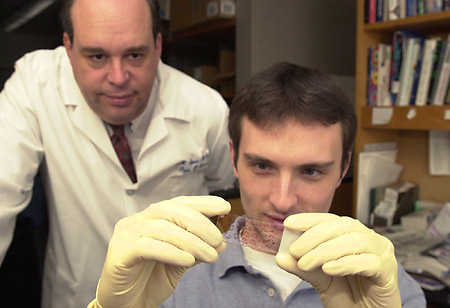Daylight savings
Student solves biological clock mystery

A 23-year-old student has gone a long way toward solving one of the big mysteries of biology – how biological clocks are set. His findings could make life easier for shift workers, astronauts, jet-lag victims, and other insomniacs.
It has long been known that changes in the cycle of day and night activate proteins in the retina of the eye, which in turn send nerve signals to a natural clock deep in the brain. But the receptors for that light, and their exact location, have remained elusive.
Earlier this year, Joshua Gooley walked into the laboratory of Clifford Saper, Putnam Professor of Neurology at Harvard Medical School, and said he wanted to work on the problem. Gooley, then a first-year graduate student, started last April and by August he had an answer.
Most of the light that enters the eye is picked up by rods and cones, light receptors that activate nerve cells. A sheet of nerve tissue, known as ganglion cells, sits in front of the rods and cones and connects to various parts of the brain including the area where visual images are formed. But some blind people and animals who lack rods and cones show the same response to light as sighted people.
“In addition to sight, the eyes are part of a completely separate system that keeps our sleep-wake cycle in sync with the rhythm of a 24-hour day,” notes Charles Czeisler, a professor of medicine at Harvard who discovered this in 1995.
Later, researchers led by Ignacio Provencio of the National Institutes of Health found that light-receptive proteins also exist in ganglion cells. Scattered among these cells are small numbers of molecules that contain a protein known as melanopsin, a close relative of opsin proteins in rods and cones.
It was after spending three months working in Cziesler’s lab that Gooley approached Saper about working on melanopsin. Graduate students rotate though a series of laboratories as part of a process to decide what subject they will pursue for a required thesis.
“Students usually don’t have a strong sense of what they want to do at this time,” Saper says. “Mostly they pick up part of a project being worked on by others. But Josh knew exactly what he wanted to do. When that happens, however, the project rarely produces such a remarkable result in such a short time. It’s a fundamental discovery.”
A connection is made
Gooley carefully injected red dye into a pinhead-size area deep in the brain known as the suprachiasmatic nucleus (SCN), the seat of the biological clock. The SCN is located in the hypothalamus, a cherry-sized area involved in regulation of sleep, body temperature, appetite, mood, and sex drive.
The Champlain, N.Y., native found a good match between melanopsin production and ganglion cells that took up the dye from the SCN. That makes melanopsin a primary candidate for relaying changes in light and darkness to brain clocks. Rods and cones may also contribute to this connection, and that possibility is being studied.
Gooley wrote a report on this work and sent it to Nature Neuroscience in August, but that scientific journal initially rejected it. Saper asked the editors to reconsider; he knew that at least one of the scientists who reviewed the report thought it was important. The journal finally called Saper on Nov. 1, and an editor told him a decision had been made to publish it. But he and Gooley had only until 3 p.m. that day to submit a revised manuscript. They met the deadline, and the report appears in the December issue of Nature Neuroscience.
Although the experiment was done in rats, Saper and Gooley believe human biological rhythms are regulated by the same mechanism. Melanopsin has been found in monkeys, and humans possess a gene that carries instructions for making that light-sensitive protein.
The key test will involve removing melanopsin from ganglion cells to see if that wrecks the timing of the biological clock. “We have begun working on this,” Gooley says.
He will work with animals, but such experiments could eventually be done on humans by using the eyes of people who have died and willed them to science. There is also a supply of eyes from blind people who have their eyes removed for reasons of pain, infection, or cosmetic replacement with artificial orbs.
Resetting the clock
Cziesler advises blind people not to have their eyes removed before determining if they still possess what he calls the “vision without sight,” that keeps them in sync with day and night. Removal could cause them a lifetime of sleep disturbances and excessive drowsiness during the day.
Light is a mixture of different frequencies, or colors. Czeisler, Saper and Gooley want to determine what frequency is best for resetting a brain clock knocked out of sync by travel across time zones, shift work, or the change of seasons. Such information could lead to practical applications for Gooley’s discovery.
Long-distance travelers, shift workers, astronauts, and those affected by “winter blues” can now adjust their daily rhythms by sitting in front of “light boxes,” banks of fluorescent bulbs that emit two to three times more light than found in a typical room at home. “That light is bright white light,” Gooley points out. “But melanopsin may respond better to a specific frequency of light, one that could reset a biological clock more efficiently. Pursing this possibility is one direction that we are now going.”
Gooley first got interested in tinkering with biological clocks when he took a course in the subject given by Cziesler and Woodland Hastings, Mangelsdorf Professor of Natural Sciences at Harvard. He has never seriously thought about doing other kinds of research since.
“There’s still plenty left to be discovered in this field,” Gooley says. “I’ll go wherever it takes me.”




